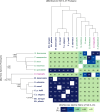Multiple horizontal transfer events of a DNA transposon into turtles, fishes, and a frog
- PMID: 38605364
- PMCID: PMC11008031
- DOI: 10.1186/s13100-024-00318-9
Multiple horizontal transfer events of a DNA transposon into turtles, fishes, and a frog
Abstract
Horizontal transfer of transposable elements (HTT) has been reported across many species and the impact of such events on genome structure and function has been well described. However, few studies have focused on reptilian genomes, especially HTT events in Testudines (turtles). Here, as a consequence of investigating the repetitive content of Malaclemys terrapin terrapin (Diamondback turtle) we found a high similarity DNA transposon, annotated in RepBase as hAT-6_XT, shared between other turtle species, ray-finned fishes, and a frog. hAT-6_XT was notably absent in reptilian taxa closely related to turtles, such as crocodiles and birds. Successful invasion of DNA transposons into new genomes requires the conservation of specific residues in the encoded transposase, and through structural analysis, these residues were identified indicating some retention of functional transposition activity. We document six recent independent HTT events of a DNA transposon in turtles, which are known to have a low genomic evolutionary rate and ancient repeats.
Keywords: DNA transposable element; Genome evolution; Horizontal transfer; Transposable element; Vertebrate.
© 2024. The Author(s).
Conflict of interest statement
The authors declare no competing interests.
Figures


References
-
- Atkinson PW. hAT Transposable Elements. Microbiol Spectr [Internet]. 2015;3. 10.1128/microbiolspec.MDNA3-0054-2014. - PubMed
LinkOut - more resources
Full Text Sources

